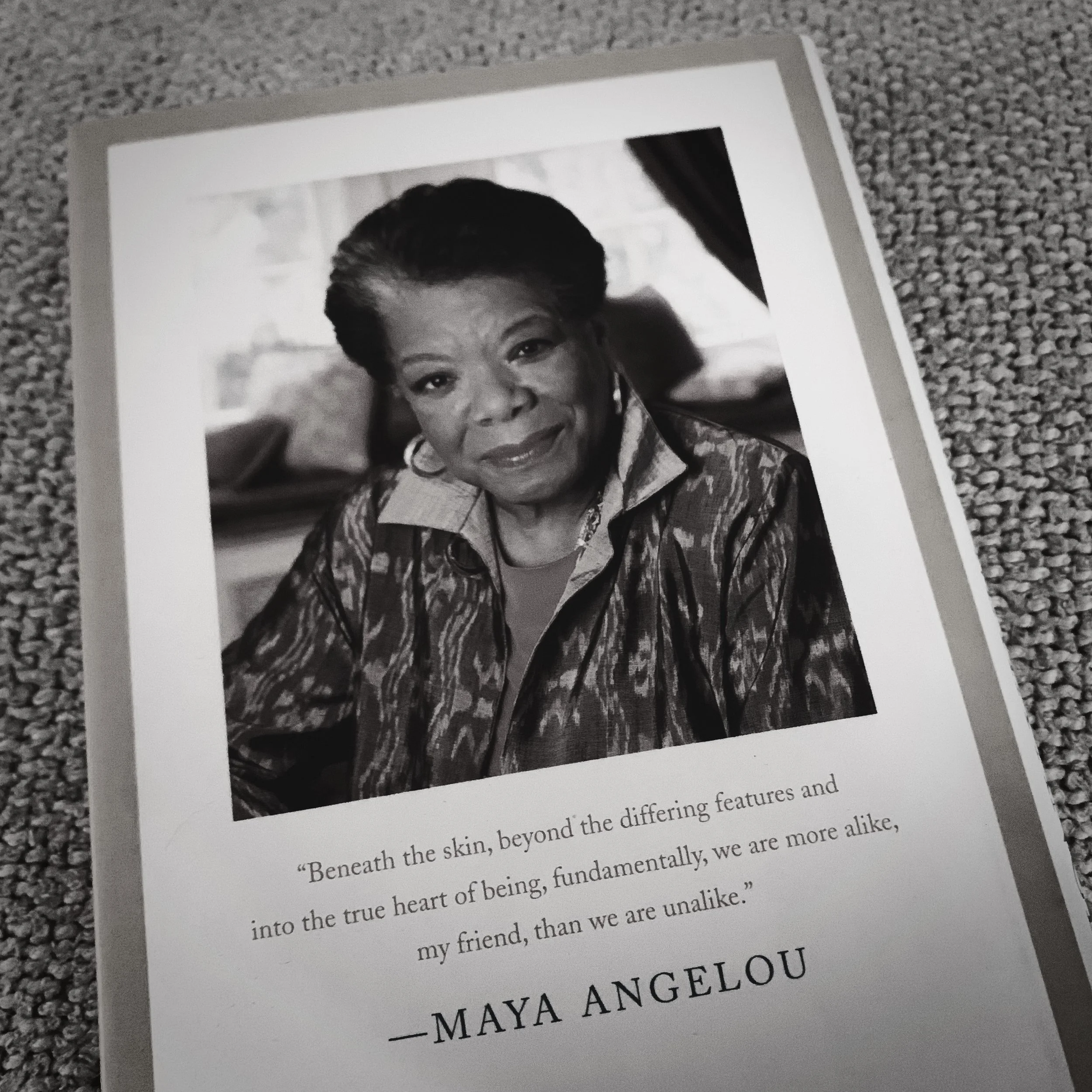Remembering the class of a lifetime
Author photo and quotation on the back of Angelou’s book Rainbow in the Cloud
When Maya Angelou died in 2014, I wrote about the heady experience of being a student in her college seminar long, long ago; I came across that essay recently and wanted to share it here.
Spring 2014
After I heard the news about Maya Angelou’s death last week, I wanted so much to see what, if anything, I had had the good sense to put on paper about the experience of being in her class at Wake Forest University.
I was a committed keeper of journals back then, but after 27 years, the chances of putting my hands on the one from that exact timeframe seemed slim. But I was determined to try, and the universe served up what felt like a small miracle. The very first notebook I pulled out of a wooden chest in the back of my closet contained this single paragraph:
Tuesday night, April 7, 1987
I began a course with Maya Angelou yesterday. She is captivating, electric, compelling ... and – at first – terrifying. It was the most stimulating, exhausting two and a half hours I have spent since I can remember.
My memories of college classes are more in the “broad brush” category these days, and I’m sad to say that I don’t recall much about the specific things we talked about in that spring seminar, which I took at the end of my senior year.
But what I do have a vivid memory of is the experience of Maya Angelou.
That bowled-over paragraph in my journal sums up the powerful impression she made on me -- an impression that has not faded over the past 27 years.
From the first moment of the first day of class, I knew this was going to be like no class I had ever taken.
She set a tone that was a little terrifying for college kids accustomed to informality; she expected things that we were not accustomed to – in college or in life in general, I think.
She announced that we were going to learn each other’s names so that we would be able to go around the room and greet each of our fellow students by name at the beginning of class – and we wouldn’t be calling each other by our first names, as I’m sure we would have expected. We would greet each other formally – Ms. Smith, Mr. Jones, etc.
She also made it clear that anyone who wasn’t able to be on time may as well just stay away that day.
I was raised to be polite, and I had always been a respectful kid, but the expectations she laid out that first day were striking. I’m not sure I could have put it into words back then, but I definitely understood that for Maya Angelou, those ground rules were not about going through the motions or being old-fashioned; they were about dignity and respect. In giving people your attention – learning their names, greeting everyone individually – and respecting their time, you communicate your regard for them.
(I can’t recall whether we talked specifically about the importance of these kinds of gestures of respect and dignity in the context of the history of slavery, but even if we didn’t, I certainly made the connection.)
At first I was petrified that I wouldn’t be able to remember my classmates’ names; I wanted very much to rise to her expectations of us.
I believe she had this effect on everyone she encountered; she was the sort of person who could walk into a room and make everyone sit up straight. Her energy couldn’t help but kick your senses into high alert; you wanted to harness even a little of it for yourself.
An unforgettable dinner party
Beyond my memory of Maya Angelou as a force of nature, I will never forget the way we ended our seminar: She invited all of us to dinner at her home, which stands as the most exciting invitation ever extended to me.
As anyone who admires Maya Angelou would understand, that evening was a highlight of my writing, reading, studying, thinking life. Unfortunately, I don’t remember the kind of minute details that you’d like to recall about an experience like that, and it’s not in my journal, either; I’m guessing I was pouring my eve-of-graduation excitement and fear into those pages during those last few weeks of college.
But again, I still have vivid broad-strokes memories.
I remember her warmth and hospitality – her genuine delight at having us in her home.
I remember wonderful food, though I can’t tell you what she made for us.
I remember sitting around in her living room/family room after dinner doing something I never dreamed I would do, something I still have a hard time wrapping my head around: We read poems that we had written. Out loud. To MAYA ANGELOU. In her living room.
It was thrilling and – to borrow an adjective from my journal entry – terrifying.
Though I would love to see what on earth I wrote and read to Maya Angelou that evening, awful as it may have been, I have no idea where that poem is.
But I do have a lasting memory of a lovely evening with a lovely woman who began our time together by teaching us how to show respect and regard for a room full of strangers and ended it by inviting us to step outside our comfort zone with a room full of fellow travelers.
When I was very young, the teacher would call the roll in class, and we would each pipe up, “Present.”
Here – I’m here, we meant.
With Maya Angelou, presence meant more than checking a box.
It was, to quote my younger self, something electric.
I can’t think of anyone I’ve ever encountered who was more fully present in life than Maya Angelou, and that was a powerful thing to behold for a 22-year-old overflowing with big dreams and heading out into the real world.
Thank you for that send-off, Phenomenal Woman.










































